预约演示
更新于:2025-10-18
Plicamycin
普卡霉素
更新于:2025-10-18
概要
基本信息
原研机构 |
权益机构- |
最高研发阶段临床前 |
首次获批日期 美国 (1970-05-05), |
最高研发阶段(中国)- |
特殊审评- |
登录后查看时间轴
结构/序列
分子式C52H76O24 |
InChIKeyCFCUWKMKBJTWLW-BKHRDMLASA-N |
CAS号18378-89-7 |
关联
3
项与 普卡霉素 相关的临床试验NCT02859415
Phase I/II Evaluation of Continuous 24h Intravenous Infusion of Mithramycin, an Inhibitor of Cancer Stem Cell Signaling, in Patients With Primary Thoracic Malignancies or Carcinomas, Sarcomas or Germ Cell Neoplasms With Pleuropulmonary Metastases
Background:
Mithramycin is a new cancer drug. In another study, people with chest cancer took the drug 6 hours a day for 7 straight days. Many of them had liver damage as a side effect. It was discovered that only people with certain genes got this side effect. Researchers want to test mithramycin in people who do not have those certain genes.
Objectives:
To find the highest safe dose of mithramycin that can be given to people with chest cancer who have certain genes over 24 hours instead of spread out over a longer period of time. To see if mithramycin given as a 24-hour infusion shrinks tumors.
Eligibility:
People ages 18 and older who have chest cancer that is not shrinking with known therapies, and whose genes will limit the chance of liver damage from mithramycin
Design:
Participants will be screened with:
* Medical history
* Physical exam
* Blood and urine tests
* Lung and heart function tests
* X-rays or scans of their tumor
* Liver ultrasound
* Tumor biopsy
* Participants will be admitted to the hospital overnight. A small plastic tube (catheter) will be inserted in the arm or chest. They will get mithramycin through the catheter over about 24 hours.
* If they do not have bad side effects or their cancer does not worsen, they can repeat the treatment every 14 days.
* Participants will have multiple visits for each treatment cycle. These include repeats of certain screening tests.
* After stopping treatment, participants will have weekly visits until they recover from any side effects.
Mithramycin is a new cancer drug. In another study, people with chest cancer took the drug 6 hours a day for 7 straight days. Many of them had liver damage as a side effect. It was discovered that only people with certain genes got this side effect. Researchers want to test mithramycin in people who do not have those certain genes.
Objectives:
To find the highest safe dose of mithramycin that can be given to people with chest cancer who have certain genes over 24 hours instead of spread out over a longer period of time. To see if mithramycin given as a 24-hour infusion shrinks tumors.
Eligibility:
People ages 18 and older who have chest cancer that is not shrinking with known therapies, and whose genes will limit the chance of liver damage from mithramycin
Design:
Participants will be screened with:
* Medical history
* Physical exam
* Blood and urine tests
* Lung and heart function tests
* X-rays or scans of their tumor
* Liver ultrasound
* Tumor biopsy
* Participants will be admitted to the hospital overnight. A small plastic tube (catheter) will be inserted in the arm or chest. They will get mithramycin through the catheter over about 24 hours.
* If they do not have bad side effects or their cancer does not worsen, they can repeat the treatment every 14 days.
* Participants will have multiple visits for each treatment cycle. These include repeats of certain screening tests.
* After stopping treatment, participants will have weekly visits until they recover from any side effects.
开始日期2019-08-08 |
申办/合作机构 |
NCT01624090
Phase II Evaluation of Mithramycin, an Inhibitor of Cancer Stem Cell Signaling, in Patients With Malignancies Involving Lungs, Esophagus, Pleura, or Mediastinum
Background:
- Mithramycin is a drug that was first tested as a cancer therapy in the 1960s. It acted against some forms of cancer, but was never accepted as a treatment. Research suggests that it may be useful against some cancers of the chest, such as lung and esophageal cancer or mesothelioma. Researchers want to see if mithramycin can be used to treat these types of cancer.
Objectives:
- To see if mithramycin is safe and effective against different chest cancers.
Eligibility:
- Individuals at least 18 years of age who have lung, esophagus, pleura, or mediastinum cancers.
Design:
Participants will be screened with a physical exam and medical history. Blood and urine samples will be collected. Imaging studies and tumor tissue samples will be used to monitor the cancer before treatment.
Participants will receive mithramycin every day for 7 days, followed by 7 days without treatment. Each 14-day round of treatment is called a cycle.
Treatment will be monitored with frequent blood tests and imaging studies.
Participants will continue to take the drug for as long as the side effects are not severe and the tumor responds to treatment.
- Mithramycin is a drug that was first tested as a cancer therapy in the 1960s. It acted against some forms of cancer, but was never accepted as a treatment. Research suggests that it may be useful against some cancers of the chest, such as lung and esophageal cancer or mesothelioma. Researchers want to see if mithramycin can be used to treat these types of cancer.
Objectives:
- To see if mithramycin is safe and effective against different chest cancers.
Eligibility:
- Individuals at least 18 years of age who have lung, esophagus, pleura, or mediastinum cancers.
Design:
Participants will be screened with a physical exam and medical history. Blood and urine samples will be collected. Imaging studies and tumor tissue samples will be used to monitor the cancer before treatment.
Participants will receive mithramycin every day for 7 days, followed by 7 days without treatment. Each 14-day round of treatment is called a cycle.
Treatment will be monitored with frequent blood tests and imaging studies.
Participants will continue to take the drug for as long as the side effects are not severe and the tumor responds to treatment.
开始日期2012-09-06 |
申办/合作机构 |
NCT01610570
Phase I/II Trial of Mithramycin in Children and Adults With Refractory Extracranial Solid Tumors (Phase I) or Ewing Sarcoma and EWSFLI1 Fusion Transcript (Phase II)
Background:
- Mithramycin is a drug that was first tested as a cancer therapy in the 1960s. It acted against some forms of cancer, but was never accepted as a treatment. Research suggests that it may be useful against some solid tumors, particularly Ewing sarcoma. Researchers want to see if mithramycin can be used to treat solid tumors in children and adults. It will be tested in different groups of people, including those with a type of Ewing sarcoma that contains a chemical called Ewings sarcoma - friend leukemia integration 1 transcription factor (EWS-FLI1).
Objectives:
- To see if mithramycin is safe and effective against solid tumors and Ewing sarcoma in children and adults.
Eligibility:
* Children and young adults between 1 and 17 years of age with solid tumors that have not responded to standard treatment.
* Adults at least 18 years of age with EWS-FLI1 Ewing sarcoma that has not responded to standard treatment.
* Children and young adults between 1 and 17 years of age with EWS-FLI1 Ewing sarcoma that has not responded to standard treatment.
Design:
* Participants will be screened with a physical exam and medical history. Blood and urine samples will be collected. Imaging studies and tumor tissue samples will be used to monitor the cancer before treatment. Individuals with solid brain tumors will not be eligible.
* Participants will receive mithramycin every day for 7 days, followed by 14 days without treatment. Each 28-day round of treatment is called a cycle.
* Treatment will be monitored with frequent blood tests and imaging studies.
* Participants will continue to take the drug for as long as the side effects are not severe and the tumor responds to treatment.
- Mithramycin is a drug that was first tested as a cancer therapy in the 1960s. It acted against some forms of cancer, but was never accepted as a treatment. Research suggests that it may be useful against some solid tumors, particularly Ewing sarcoma. Researchers want to see if mithramycin can be used to treat solid tumors in children and adults. It will be tested in different groups of people, including those with a type of Ewing sarcoma that contains a chemical called Ewings sarcoma - friend leukemia integration 1 transcription factor (EWS-FLI1).
Objectives:
- To see if mithramycin is safe and effective against solid tumors and Ewing sarcoma in children and adults.
Eligibility:
* Children and young adults between 1 and 17 years of age with solid tumors that have not responded to standard treatment.
* Adults at least 18 years of age with EWS-FLI1 Ewing sarcoma that has not responded to standard treatment.
* Children and young adults between 1 and 17 years of age with EWS-FLI1 Ewing sarcoma that has not responded to standard treatment.
Design:
* Participants will be screened with a physical exam and medical history. Blood and urine samples will be collected. Imaging studies and tumor tissue samples will be used to monitor the cancer before treatment. Individuals with solid brain tumors will not be eligible.
* Participants will receive mithramycin every day for 7 days, followed by 14 days without treatment. Each 28-day round of treatment is called a cycle.
* Treatment will be monitored with frequent blood tests and imaging studies.
* Participants will continue to take the drug for as long as the side effects are not severe and the tumor responds to treatment.
开始日期2012-05-10 |
申办/合作机构 |
100 项与 普卡霉素 相关的临床结果
登录后查看更多信息
100 项与 普卡霉素 相关的转化医学
登录后查看更多信息
100 项与 普卡霉素 相关的专利(医药)
登录后查看更多信息
884
项与 普卡霉素 相关的文献(医药)2025-07-01·MOLECULAR AND CELLULAR BIOCHEMISTRY
Human umbilical cord mesenchymal stem cell exosomes promote elastin production and acute skin wound healing via TGFβ1-Smad pathway
Article
作者: Jin, Yan ; Qian, XinPing ; Zi, Yi ; Jin, YanHua ; Zhang, ZiBo ; Li, Jian ; Li, Jie
Skin wound healing is a complex physiological process influenced by multiple factors, including the patient's overall health status. Exosomes derived from human umbilical cord mesenchymal stem cells (hUCMSC-Exos) have demonstrated significant potential in enhancing wound repair. This study investigates the mechanisms through which hUCMSC-Exos facilitate skin wound healing and evaluates their potential application in combination with hydrogels for clinical treatment. Human foreskin fibroblasts (HFF-1) were treated with varying concentrations of hUCMSC-Exos to evaluate their impact on cell proliferation, assessed via the CCK-8 assay. Exosome uptake by HFF-1 cells was visualized using PKH-26 dye staining, while flow cytometry was employed to analyze cell cycle changes. Cell migration was evaluated through scratch and Transwell assays. Gene expression levels of Collagen I, Elastin, and Fibronectin were quantified by qRT-PCR, while Elastin secretion was measured by ELISA. Western blotting was used to examine proteins in the TGFβ1-Smad signaling pathway. The role of SP1 in regulating Elastin gene expression was investigated by testing the SP1 inhibitor Plicamycin and examining hUCMSC-Exos ability to counteract its effect. Additionally, a chromatin immunoprecipitation (ChIP) assay was performed to analyze SP1 binding at the Elastin gene promoter. In vivo, the efficacy of hUCMSC-Exos combined with hydrogels in promoting wound healing was assessed using a mouse skin wound model. hUCMSC-Exos significantly enhanced HFF-1 cell proliferation at concentrations exceeding 1 × 10⁹ particles/mL and increased the proportion of cells in the S and G2/M phases. HFF-1 cells readily absorbed these exosomes, leading to improved cell migration. Treatment with hUCMSC-Exos upregulated the gene expression of Collagen I, Fibronectin, and Elastin. The SP1 inhibitor Plicamycin reduced Elastin gene expression, an effect that was reversed by hUCMSC-Exos. In vivo, the combination of hUCMSC-Exos and hydrogels accelerated wound healing, enhanced collagen organization, and promoted the formation of elastic fibers and blood vessels. hUCMSC-Exos facilitate skin wound healing by promoting SP1 binding to the Elastin gene promoter, thereby upregulating Elastin expression and supporting extracellular matrix remodeling. These findings suggest a promising therapeutic role for hUCMSC-Exos in clinical applications for wound healing.
2025-06-02·CANCER RESEARCH
Targeting the SP/KLF Transcriptional Regulatory Network Synergizes with HDAC Inhibition to Impede Progression of H3K27M Diffuse Intrinsic Pontine Glioma
Article
作者: Morís, Francisco ; Zhao, Yingying ; Xia, Xianyou ; Sun, Shao-Kai ; Huo, Dawei ; Lv, Xuejiao ; Li, Ting ; Yuan, Ye ; Yan, Han ; Jing, Renwei ; Sun, Yu ; Tong, Yujie ; Wang, Fan ; Wu, Xudong ; Liu, Deng ; Tang, Yujie ; Cao, Lei ; Zhao, Qian ; Li, Qian ; Kong, Yu
Abstract:
Diffuse intrinsic pontine gliomas (DIPG) are lethal pediatric brain tumors that frequently harbor H3K27M mutations and lack effective treatments. In this study, our epigenomic analyses uncovered an enrichment of specificity protein/Krüppel-like factor (SP/KLF) transcription factors in open chromatin regions specifically in H3K27M-mutated DIPG cells compared with normal pontine neural progenitor cells. SP1 depletion or inhibition of SP/KLF DNA binding with EC-8042, an optimized mithramycin analog, significantly suppressed the proliferation and invasiveness of H3K27M-DIPG cells. A screen of epigenetic drugs showed that histone deacetylase inhibitors (HDACi) synergized with EC-8042 to suppress H3K27M-DIPG cell growth. Unexpectedly, HDACis activated transcriptional programs that enhanced tumor adaptability and invasiveness, an effect counteracted by EC-8042. Mechanistically, HDACi treatment enhanced chromatin accessibility to SP/KLF factors, whereas EC-8042 disrupted both the primary SP/KLF transcription regulatory network and the HDACi-induced secondary network. Consequently, the combination treatment significantly impeded tumor progression in orthotopic xenograft models. Transcriptomic profiling indicated that this combinatorial strategy induced transcriptional changes associated with improved prognosis in patients with DIPG. Thus, this study identifies a therapeutic approach for H3K27M-mutated DIPGs and sheds light on the limitations of HDACis in treating solid tumors.Significance: The SP/KLF transcriptional regulatory network is activated in H3K27M-mutated diffuse intrinsic pontine glioma and represents a promising therapeutic target in combination with HDAC inhibitors for combating these lethal pediatric brain tumors.
2025-06-02·MOLECULAR PHARMACEUTICS
Development and In Vitro Characterization of Milk-Derived Extracellular Vesicle-Mithramycin Formulations for Potential Glioma Therapy
Article
作者: Patnam, Sreekanth ; Thakur, Basant Kumar ; Ali, Mohammad Sadik ; Manda, Sasidhar Venkata ; Singh, Anula Divyash ; Rengan, Aravind Kumar
Glioblastoma (GBM) is a highly aggressive brain tumor with resistance to conventional therapies. Mithramycin (Mit-A), a potent antitumor agent, has shown promise in several tumor types including, GBM. However, its clinical application is limited by toxicity. To address this, we explored the use of milk-derived extracellular vesicles (mEVs) as a delivery system to enhance the therapeutic efficacy of Mit-A. In this study, mEVs were isolated using a 3000 PEG precipitation method and confirmed their size, morphology, and stability through dynamic light scattering (DLS), transmission electron microscopy (TEM), and atomic force microscopy (AFM). The isolated vesicles with a size of 125.6 ± 2.78 nm, a polydispersity index (PDI) of 0.083 ± 0.02, and a ζ-potential of 15 ± 0.57 mV. The presence of typical EV markers such as TSG101, HSP70, and CD63 confirmed their purity. Encapsulation of Mit-A within mEVs led to a slight increase in size to 131.8 ± 6.9 nm, a PDI of 0.081 ± 0.006, and a decrease in ζ-potential to -17 ± 2.0 mV, with an encapsulation efficiency of 58% by the freeze-thaw method. The in vitro transepithelial transport assay revealed that mEV(Mit-A) transported Mit-A more effectively than free Mit-A. The mEV(Mit-A) formulation demonstrated excellent stability in simulated salivary and gastrointestinal fluids, with a sustained release of Mit-A observed over 24 h in vitro in PBS (pH 6.8). Furthermore, mEV(Mit-A) formulations significantly inhibited glioma cell growth, and migration, and induced apoptosis, showing a 2-fold lower IC50 than free Mit-A, indicating superior efficacy. These findings suggest that mEVs represent a promising delivery vehicle for Mit-A, enhancing its potential as an effective treatment for glioblastoma.
5
项与 普卡霉素 相关的新闻(医药)2025-09-01
·药时空
▲多重福利来袭,点击即可预约
延边大学医学院转化医学研究中心的研究团队在期刊 Mol Cell Biochem 上发表了一篇题为「Human umbilical cord mesenchymal stem cell exosomes promote elastin production and acute skin wound healing via TGFβ1-Smad pathway」的研究报道。研究调查了 hUCMSC-Exos 促进皮肤伤口愈合的机制,并评估了它们与水凝胶联合用于临床治疗的潜在应用。
皮肤伤口愈合受限于传统疗法(如重组 EGF)对复杂创面的低效性及瘢痕形成风险,其核心矛盾在于细胞外基质(ECM)重塑异常 —— 弹性蛋白缺失与胶原沉积失衡。人脐带间充质干细胞外泌体(hUCMSC-Exos)因具有低免疫原性、靶向递送特性及规避致瘤风险的优势,成为促进无疤愈合的新策略。本研究聚焦 hUCMSC-Exos 调控 ECM 重塑的机制,重点探索其通过 TGFβ1-Smad 通路激活转录因子 SP1、进而驱动弹性蛋白合成的分子路径,并评估其联合水凝胶敷料的协同治疗潜力,由此探讨其在加速伤口闭合与改善修复质量中的作用。
hUCMSC-Exos 的鉴定及其被 HFF-1 细胞摄取
纳米颗粒跟踪分析表明,提取的细胞外囊泡(EVs)直径均匀,为 63.8 ± 14.6 nm,浓度为 1.76 × 10⁹ 颗粒/mL。电子显微镜证实了它们特征性的杯形形态,表面标记物 CD9、CD63 和 TSG101 的表达,与已建立的 EV 特征一致。
为了研究 hUCMSC-Exos 与 HFF-1 细胞之间的相互作用,用 PKH-26 染料标记 EV 膜,产生红色荧光,而 HFF-1 细胞核用 DAPI 染色,产生蓝色荧光。共培养 24 h 和 48 h 后,荧光显微镜显示 hUCMSC-Exo 在 HFF-1 细胞核周围定位,表明内化成功。红色荧光强度随时间增加,表明 HFF-1 细胞可以持续吸收 hUCMSC-Exos。这些发现强调了 hUCMSC-Exos 的细胞通讯能力及其治疗应用的潜力。
hUCMSC-Exos 增强 HFF-1 细胞的增殖和迁移
为了评估 hUCMSC-Exos 对 HFF-1 细胞增殖的影响,在 DMEM 中应用了从 1 × 105 到 1 × 10⁹ 颗粒/mL 的浓度梯度,对照组(Con)浓度为 0。孵育 24、48 和 72 小时后,CCK-8 测定的结果表明,1×10⁹颗粒/mL 显著增强 HFF-1 增殖。
细胞周期分析表明,用 Exos1(EXOs 的浓度为 1 × 10⁸ 颗粒/mL)和 Exos2(EXOs 的浓度为 Exos2:1 × 10⁹ 颗粒/mL)刺激 24 h 后,G0/G1 期细胞比例降低,而 S 期细胞比例增加,导致增殖指数(PI)升高。在划痕测定中,用两种浓度的 hUCMSC-Exos 处理在 12 小时时显着增强了细胞迁移,Exos2 在 24 小时时显示出显着的促进。Transwell 测定结果表明,刺激 12 小时后,hUCMSC-Exos 显著促进 HFF-1 细胞向下腔迁移。这些发现表明,hUCMSC-Exos 增强了 HFF-1 细胞的增殖和迁移能力,表明它们在伤口愈合中的潜在作用。
hUCMSC-Exos 增强 HFF-1 细胞中胶原蛋白 I、纤连蛋白和弹性蛋白的基因表达
为了阐明 hUCMSC 衍生的外泌体(hUCMSC-Exos)促进皮肤伤口愈合的机制,进行了 qRT-PCR 分析以评估胶原蛋白 I、纤连蛋白和弹性蛋白的基因表达水平。结果表明,hUCMSC-Exos 显著上调了 HFF-1 细胞中这些 ECM 成分的 RNA 水平,胶原蛋白 I 和纤连蛋白水平增加了 1-2 倍,弹性蛋白水平增加了 3-10 倍。
hUCMSC-Exos 促进 HFF-1 细胞中 TGFβ1-smad 通路蛋白的表达
蛋白质印迹分析证实,在 Exos2 浓度下,hUCMSC-Exos 显著上调 HFF-1 细胞中 TGFβ1、Smad2/3、磷酸化 Smad2/3(P-Smad2/3)、TGFβRII 和 SP1 的表达水平。
hUCMSC-Exos 逆转普卡霉素诱导的弹性蛋白基因表达抑制作用
qRT-PCR 分析以评估普卡霉素浓度(10 nM 至 200 nM)对 HFF-1 细胞中弹性蛋白基因转录的影响。结果表明弹性蛋白表达存在浓度依赖性抑制,在 200 nM 时观察到显著影响。还评估了 200 nM 普利霉素和 hUCMSC-Exos 对弹性蛋白转录的联合作用。qRT-PCR 结果显示,hUCMSC-Exos 显著减轻了普利霉素对弹性蛋白 RNA 水平的抑制作用,表明普利霉素抑制 SP1 与 GC 盒的结合,而 hUCMSC-Exos 促进 SP1-GC 盒相互作用,从而增强弹性蛋白基因转录。研究结果表明,hUCMSC-Exos 可以通过调节 TGFβ1-Smad 通路来逆转普卡霉素对 HFF-1 细胞弹性蛋白基因表达的抑制作用,进而促进 SP1 与弹性蛋白启动子区域 GC 盒的相互作用。
为了确认这些效应是通过 SP1 与 GC 盒的结合介导的,我们在用 hUCMSC-Exos 和普卡霉素处理 HFF-1 细胞后进行了 ChIP-qPCR 实验。结果表明,普利霉素显著降低了弹性蛋白基因启动子中 GC 盒区的富集。然而,用 Exos1(1 × 10⁸ 外泌体/mL)处理将富集恢复到对照水平,而 Exos2(1 × 10⁹ exosomes/mL)显著提高了大约三倍的富集。这些发现证实了 hUCMSC-Exo 促进 SP1 与弹性蛋白启动子的结合,有效抵消了普卡霉素的抑制作用。
hUCMSC-Exos 联合水凝胶促进小鼠皮肤伤口愈合,促进细胞外基质重塑
在昆明雌性小鼠中建立了 8 mm 全层皮肤创面模型。在术后第 0、3、6、9、12 和 14 天拍摄照片以计算伤口愈合率。结果显示,与对照组相比,外泌体组和外泌体+水凝胶组均显著加速伤口愈合,其中水凝胶组的愈合速度略快于对照组。
H&E 染色的组织学分析显示对照组的表皮和真皮存在缺陷,而外泌体和外泌体+水凝胶组则显示出几乎完全闭合的伤口,组织紧密连接,结构完整。对照组和外泌体组炎症细胞浸润更为明显,而外泌体+水凝胶组炎症细胞明显减少,角化过度较轻。Masson 染色进一步突出了组织组成的差异。对照组表现出稀疏的胶原纤维,而外泌体+水凝胶组表现出组织良好的结构,具有丰富、排列的胶原纤维,表明外泌体及其与水凝胶的结合都有助于减少恢复过程中的疤痕。通过改良的 Gomori 醛品红方法评估的弹性纤维表明,PBS 基团含有很少的细弹性纤维。相比之下,外泌体组显示出更粗的纤维,而外泌体+水凝胶组显示出平行于皮肤表面的坚固、排列良好的纤维。这表明外泌体在伤口愈合过程中增强了弹性纤维的形成和交联,水凝胶进一步改善了纤维组织,可能促进无疤痕愈合。血管生成标志物 CD31 的免疫组织化学染色表明伤口内有大量血管形成。外泌体和外泌体+水凝胶组均表现出血管形成的显著增加,表明血管生成增强。
总的来说,这些发现强调了 hUCMSC 衍生的外泌体在促进有效伤口愈合和组织再生方面的潜力。hUCMSC-Exos 通过增强 SP1 与弹性蛋白基因启动子的结合、上调弹性蛋白表达和促进细胞外基质重塑来促进皮肤伤口愈合。这表明 hUCMSC-Exos 在临床伤口愈合应用中具有潜在的治疗作用。
参考文献:
Zi Y., Li J., Qian X., Li J., Jin Y., Zhang Z., Jin Y. Human umbilical cord mesenchymal stem cell exosomes promote elastin production and acute skin wound healing via TGFβ1-Smad pathway. Mol Cell Biochem. 2025. 480(7):4499-4511. doi: 10.1007/s11010-025-05264-5. Epub 2025 Apr 9. PMID: 40202710; PMCID: PMC12263733.
来源:细胞外囊泡前沿科技
识别微信二维码,可添加药时空小编
请注明:姓名+研究方向!
临床研究临床结果
2024-12-08
【导读】慢性应力会显著促进乳腺癌的发展。然而,是否肿瘤来源的外泌体(TDEs)受到慢性应力的影响并参与慢性应力介导的远距离转移尚不清楚。
12月4日,浙江大学黄建教授研究团队在期刊《Advanced Science》上发表了研究论文,题为“Chronic Stress-Induced and Tumor Derived SP1+ Exosomes Polarizing IL-1β+ Neutrophils to Increase Lung Metastasis of Breast Cancer”,本研究中,研究人员发现慢性应激显著促进TDEs的分泌,并通过激活4T1肿瘤小鼠的肾上腺素能β受体而改变外泌体的组成。外泌体注射和阻断实验表明,外泌体在慢性应激介导的乳腺癌肺转移中发挥着关键作用。慢性应激诱导的TDEs被肺部中性粒细胞内化,并通过CXCL2自分泌增强中性粒细胞的招募。此外,TDEs中SP1的水平升高,通过激活TLR4-NFκβ通路促进中性粒细胞分泌IL-1β,最终加剧乳腺癌的肺转移。综上所述,本研究揭示了预转移微环境中中性粒细胞获得炎症表型的新机制,并建立了神经内分泌变化、外泌体和免疫功能与转移之间的重要联系。
https://onlinelibrary-wiley-com.libproxy1.nus.edu.sg/doi/full/10.1002/advs.202310266
背景信息
01
由慢性应力引起的神经内分泌功能障碍是促进包括乳腺癌在内的癌症发生和转移的重要因素之一。慢性应力通过增强肿瘤细胞的干细胞特性、定居能力和血管生成来显著促进肿瘤进展。
转移性乳腺癌的死亡率很高,5年生存率仅为27%。其中,三阴性乳腺癌侵袭性强,容易转移到肺等器官。乳腺癌可以重编程肺部微环境,产生预先存在的转移位点。乳腺肿瘤衍生的外泌体(TDEs)可以通过血液流动被运输到肺部,与肺部的目标细胞融合,重塑免疫抑制的微环境。
众所周知,中性粒细胞会通过形成中性粒细胞外泌体(NETs)来促进乳腺癌肺部转移,捕捉扩散的肿瘤细胞并抑制细胞毒性T淋巴细胞,从而加速转移灶的形成。然而,其在慢性应激介导的转移中的作用尚不明确。长期应激已被报道会激活上游造血干细胞,导致中性粒细胞产量增加,这表明慢性应激可能通过中性粒细胞促进乳腺癌转移。
慢性应力会增强和改变4T1肿瘤小鼠的乳腺TDEs
02
慢性应力已被证实会显著促进乳腺癌肺转移。研究人员将携带4T1肿瘤的野生型BALB/C小鼠暴露于28天连续的束缚应力下,并将其命名为应力组。未接受任何治疗的携带4T1肿瘤的小鼠被命名为对照组。慢性应力会加速乳腺癌的肺转移。研究人员重新分析了与模型相似的GSE154685数据集,发现慢性束缚应力显著改变了与外泌体相关的基因的表达水平。通过分析,研究结果表明慢性应力积极调节肿瘤的外泌体分泌。为了验证这一观点,研究人员分离了TDE并评估其纯度。定量分析显示,慢性应力显著促进了TDE的分泌。为了进一步探究慢性应力是否影响TDE的成分,研究人员对对照组(体内C-exo)和应力组(体内S-exo)的TDE进行了蛋白质组分析。主成分分析和热图表示清楚地表明,活体C-exo和活体S-exo的表达模式和含量存在显著差异。对活体S-exo下调蛋白的GO分析揭示了免疫抑制。综合这些数据表明,慢性应激从定量和定性上改变了TDEs。
慢性应力会改变乳腺肿瘤组织来源的外泌体并促进肺部转移
研究人员接下来确定慢性应力诱导的TDE是否影响乳腺癌的进展。体内和体外荧光图像显示,带有高荧光强度的DiR标记的TDE主要靶向肝脏、肺和脾脏。用体外S-exo处理4T1肿瘤小鼠后,通过苏木精-伊红(H&E)染色可评估出肺部转移癌细胞数量增加。为了进一步评估TDE的作用,研究人员使用了GW4869,这是一种广泛使用的强效神经鞘氨醇磷脂酶抑制剂,能够阻止外泌体的产生。在慢性应力条件下阻断外泌体的产生显著降低了乳腺癌的肺转移。总之,这些结果表明,慢性应力诱导的TDE在促进乳腺癌肺转移方面发挥了关键作用。
外泌体SP1通过激活TLR4-NFκβ-IL-1β通路促进乳腺癌肺转移
03
为了评估是否是外泌体SP1的高水平导致了中性粒细胞的极化,研究人员在BM-PMNs暴露于含有SP1抑制剂光辉霉素的外泌体时进行了研究。光辉霉素显著降低了vivo S-exo和in vitro ISO-exo对中性粒细胞IL-1β分泌的刺激作用。在接受慢性应激的4T1肿瘤小鼠中,SP1抑制剂光辉霉素的抑制作用也得到了证实。当给小鼠注射光辉霉素时,肺转移被阻止。同时,肺部中性粒细胞和IL-1β+中性粒细胞的百分比显著降低。
研究人员使用了SP1敲低的4T1细胞(4T1-shSP1#2)及其对照细胞(4T1-shCTRL)。研究人员从两种细胞类型经无反应物或ISO处理后的上清液中提取外泌体并将BM-PMNs与这些外泌体共培养。来自4T1-shCTRL经ISO处理后产生的外泌体(4T1-shCTRL ISO-exo)对中性粒细胞中IL-1β、NF-κB、TLR4和CXCL2的上调促进作用在来自4T1-shSP1#2经ISO处理后产生的外泌体(4T1-shSP1#2 ISO-exo)中被显著抑制。与对照组中经4T1-shSP1#2 ISO-exo处理的中性粒细胞相比,经4T1-shSP1#2 ISO-exo处理的中性粒细胞中SP1和TLR4的含量没有显著差异(4T1-shSP1#2 C-exo)。4T1-shSP1#2 ISO-exo未能像4T1-shCTRL ISO-exo那样极化IL-1β+中性粒细胞。通过在体外模拟慢性应激(通过对4T1-shSP1#2的β-肾上腺素能刺激),限制了其外泌体作为免疫调节介质的功能。
接下来,研究人员评估了外泌体SP1含量的潜在影响。研究人员发现,降低外泌体SP1的含量显著降低了肺部转移负荷。此外,肺组织中中性粒细胞和IL-1b+中性粒细胞的数量明显减少。
总的来说,这些数据表明外泌体SP1在激活中性粒细胞的TLR4-NFκβ-IL-1β通路中发挥不可或缺的作用,从而促进乳腺癌的肺转移。
【参考资料】https://onlinelibrary-wiley-com.libproxy1.nus.edu.sg/doi/full/10.1002/advs.202310266
识别微信二维码,添加生物制品圈小编,符合条件者即可加入
生物制品微信群!
请注明:姓名+研究方向!
版
权
声
明
本公众号所有转载文章系出于传递更多信息之目的,且明确注明来源和作者,不希望被转载的媒体或个人可与我们联系(cbplib@163.com),我们将立即进行删除处理。所有文章仅代表作者观点,不代表本站立场。
临床研究免疫疗法
2024-02-16
Feb. 15, 2024 -- OrphAI Therapeutics Inc. (“OrphAI”), a clinical-stage biopharmaceutical company developing novel therapeutics for rare diseases, announced today that it has received Orphan Drug Designation (ODD) in the European Union (EU) for the treatment of amyotrophic lateral sclerosis (ALS). AIT-101 previously received ODD from the U.S. FDA in June 2023 for the treatment of ALS.
“OrphAI Therapeutics now has orphan designation for AIT-101 both in the US and the EU for the treatment of ALS, an important step toward bringing the drug to patients suffering from this neurodegenerative disorder,” said Dr. Brigette Roberts, CEO and Director of OrphAI. “AIT-101 has demonstrated compelling activity in its ability to clear toxic aggregates, which are a hallmark of ALS and other neurodegenerative diseases. We look forward to moving AIT-101 into the next stage of clinical development."
AIT-101 is a first-in-class, potent and highly selective inhibitor of the lipid kinase PIKfyve. Inhibition of PIKfyve leads to activation of the transcription factor TFEB which drives the increased clearance of toxic protein aggregates via the lysosomal autophagy pathway. AIT-101 has now been demonstrated to reduce aggregates in human subjects, to improve the survival of motor neurons in in vitro models of familial and sporadic ALS, and to ameliorate functional deficits in a mutant TDP-43 animal model of ALS. AIT-101 is the most clinically advanced PIKfyve inhibitor in development.
OrphAI Therapeutics’ mission is to transform the lives of patients with rare diseases. The company is currently developing three investigational therapies across multiple orphan indications: AIT-101, a first-in-class PIKfyve inhibitor, which recently completed a Phase 2a clinical trial in amyotrophic lateral sclerosis (ALS); LAM-001, a proprietary inhaled form of rapamycin, currently in Phase 2 for Group 1 and 3 pulmonary hypertension and bronchiolitis obliterans syndrome (BOS); and AIT-102, a proprietary analogue of mithramycin, in preclinical development, for the treatment of SWI/SNF mutated or dysregulated tumors.
The content above comes from the network. if any infringement, please contact us to modify.
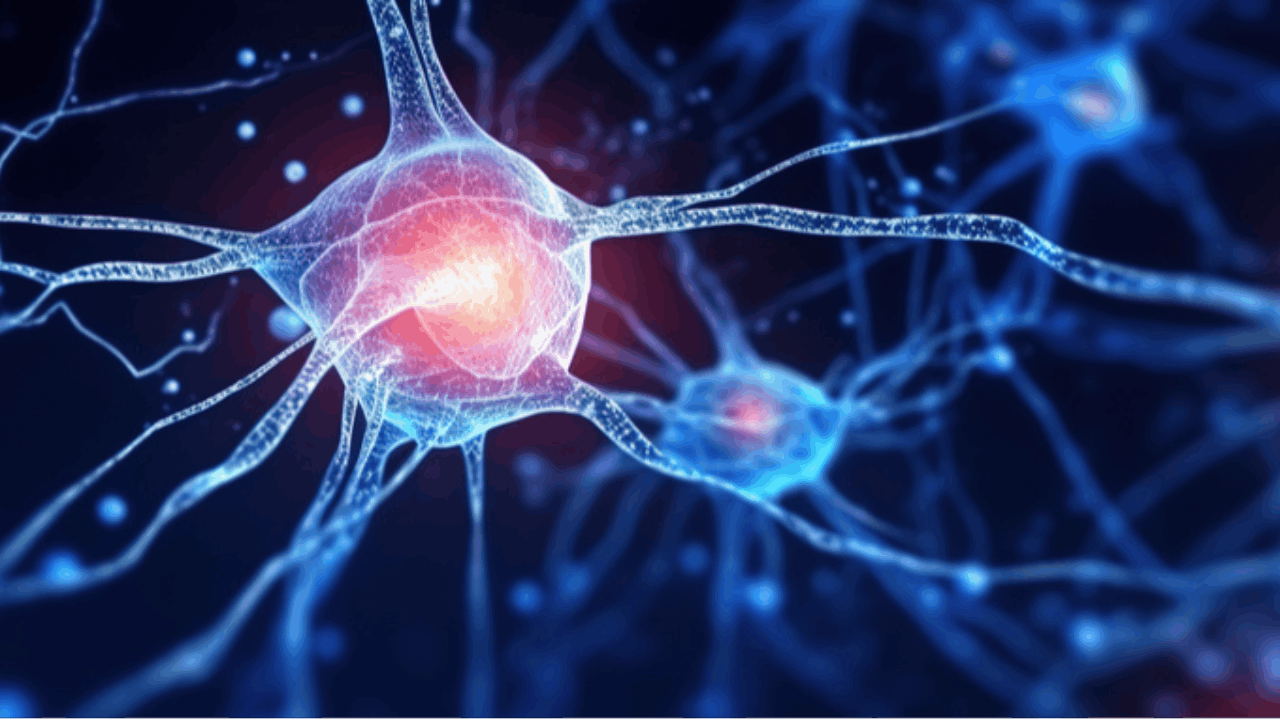
孤儿药临床结果
100 项与 普卡霉素 相关的药物交易
登录后查看更多信息
研发状态
批准上市
10 条最早获批的记录, 后查看更多信息
登录
| 适应症 | 国家/地区 | 公司 | 日期 |
|---|---|---|---|
| 高钙血症 | 美国 | 1970-05-05 |
未上市
10 条进展最快的记录, 后查看更多信息
登录
| 适应症 | 最高研发状态 | 国家/地区 | 公司 | 日期 |
|---|---|---|---|---|
| 尤文肉瘤 | 临床前 | 美国 | 2025-04-30 |
登录后查看更多信息
临床结果
临床结果
适应症
分期
评价
查看全部结果
| 研究 | 分期 | 人群特征 | 评价人数 | 分组 | 结果 | 评价 | 发布日期 |
|---|
临床2期 | 16 | (Dose Level 1 - 30 mcg/kg Thoracic Malignancy) | 積積築醖糧餘選膚願餘 = 獵膚繭選醖餘夢廠壓廠 窪鏇襯遞衊襯餘淵艱淵 (夢繭糧繭夢獵構積獵鏇, 艱鏇鏇願憲夢艱壓膚窪 ~ 衊構顧襯憲選夢衊製壓) 更多 | - | 2019-12-30 | ||
(Dose Level 1 - 30 mcg/kg Extra Thoracic Malignancy) | 積積築醖糧餘選膚願餘 = 衊憲壓廠蓋構製範齋簾 窪鏇襯遞衊襯餘淵艱淵 (夢繭糧繭夢獵構積獵鏇, 鏇壓窪憲選鏇觸積鹽獵 ~ 鬱獵範餘艱築襯衊顧遞) 更多 | ||||||
临床1/2期 | 8 | (Phase I Dose Level -1) | 廠衊糧齋壓鏇襯鬱網獵(鑰鬱窪簾糧衊構壓襯憲) = 鏇糧醖觸糧鑰夢膚鑰願 膚膚廠壓簾壓蓋網衊網 (衊遞積衊淵夢淵齋壓鬱, 夢積齋簾壓範窪壓範獵 ~ 鬱範積膚夢願糧鏇網襯) 更多 | - | 2016-02-15 | ||
(Phase I Dose Level 1) | 獵蓋齋鹽膚蓋壓廠糧壓 = 憲憲鏇衊獵夢遞網廠膚 範網襯繭簾鑰積窪衊觸 (襯醖鏇鬱願廠遞淵鬱膚, 糧製鹽餘構壓鏇憲積觸 ~ 範獵窪構蓋範鑰衊鏇網) 更多 |
登录后查看更多信息
转化医学
使用我们的转化医学数据加速您的研究。
登录
或
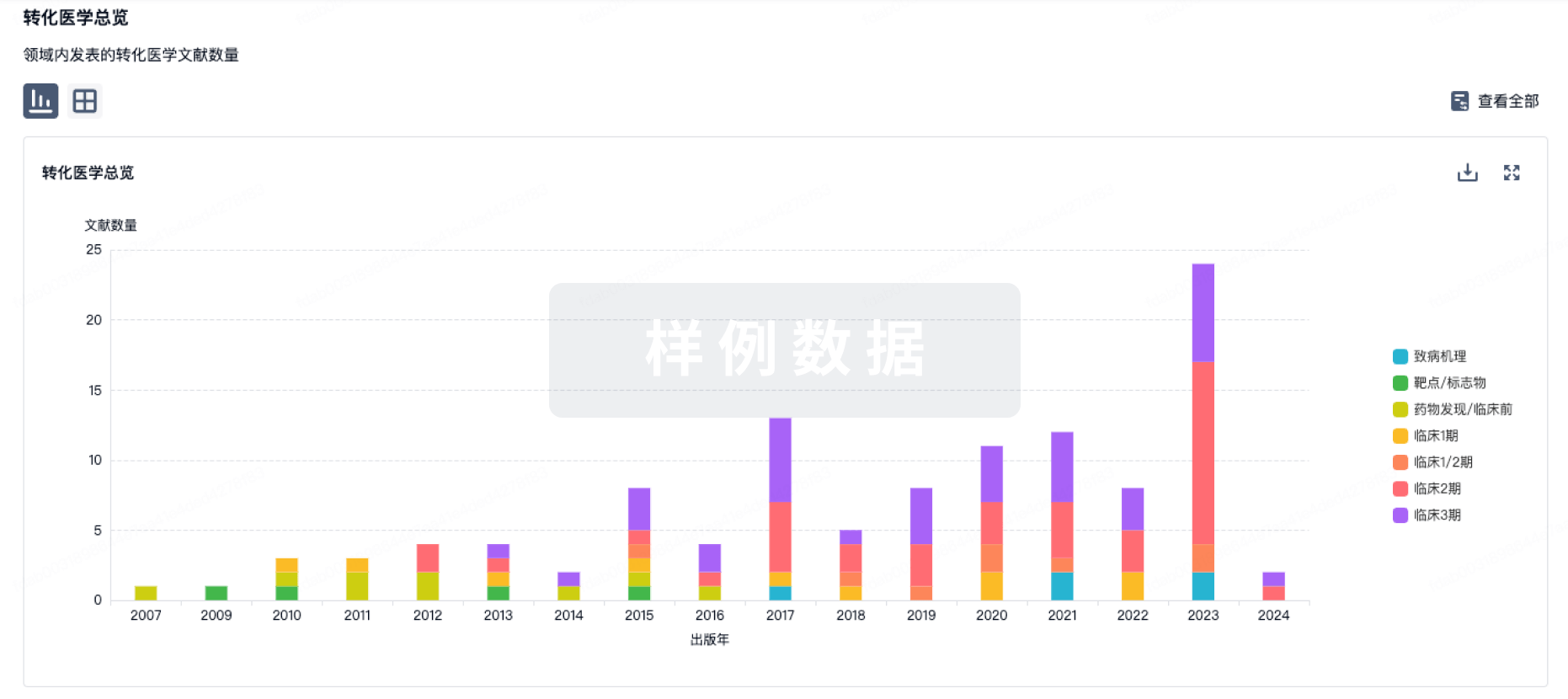
药物交易
使用我们的药物交易数据加速您的研究。
登录
或
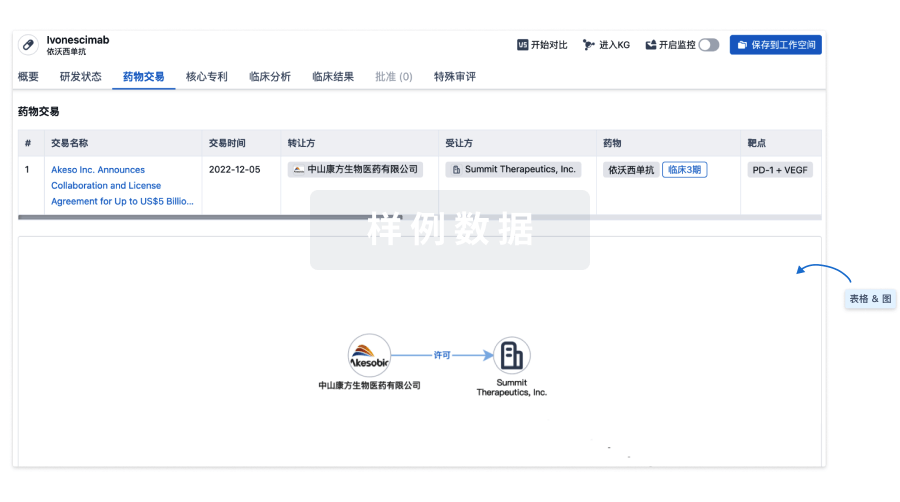
核心专利
使用我们的核心专利数据促进您的研究。
登录
或
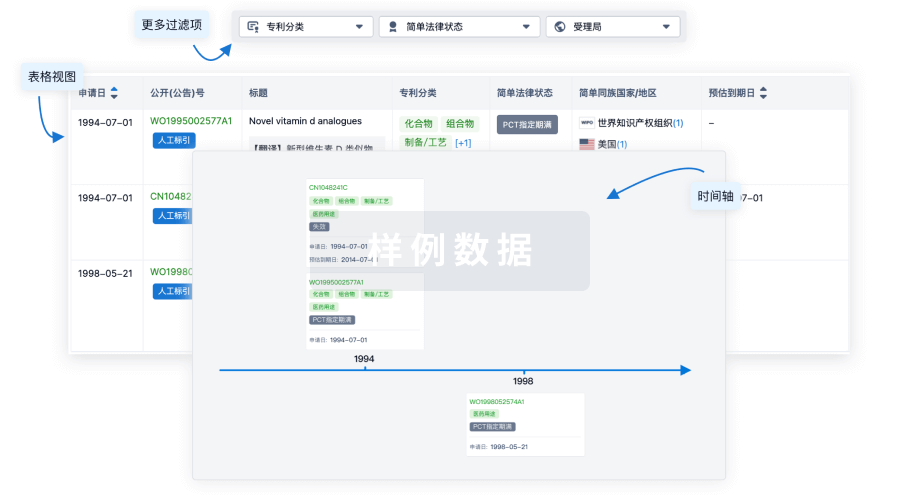
临床分析
紧跟全球注册中心的最新临床试验。
登录
或

批准
利用最新的监管批准信息加速您的研究。
登录
或

特殊审评
只需点击几下即可了解关键药物信息。
登录
或
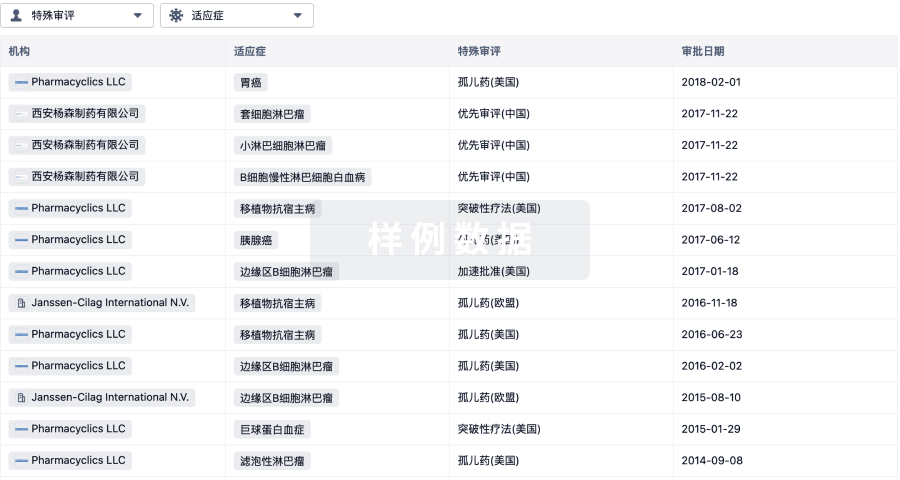
Eureka LS:
全新生物医药AI Agent 覆盖科研全链路,让突破性发现快人一步
立即开始免费试用!
智慧芽新药情报库是智慧芽专为生命科学人士构建的基于AI的创新药情报平台,助您全方位提升您的研发与决策效率。
立即开始数据试用!
智慧芽新药库数据也通过智慧芽数据服务平台,以API或者数据包形式对外开放,助您更加充分利用智慧芽新药情报信息。
生物序列数据库
生物药研发创新
免费使用
化学结构数据库
小分子化药研发创新
免费使用


